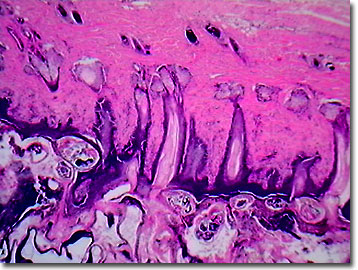Brightfield Digital Image Gallery
Scabies Infestation (Sarcoptes scabiei)
Scabies, Sarcoptes scabiei, represent the itch or mange mites responsible for sarcoptic mange in domestic and wild animals, such as horses and wolves, as well as the parasitic infection that has irritated humans since the dawn of civilization. Awareness of the Acari arachnids dates back to ancient Egypt (1550 BC), where they were featured throughout the writings of the major Greek scholars.

View a high magnification image of the scabies infested tissue.
In humans, mite transmission occurs by physical contact, either skin to skin or via contaminated upholstery or bedding. Male and female Sarcoptes mites mate on the skin and the female then burrows into the skin. There, she can live as long as two months, burrowing throughout the skin tissue. Excretory and secretory substances produced by the female scabies mite create intense itching sensations in the host, followed by a bad rash and characteristic subdermal "tracks". Secondary infections of the rashes, as a result of scratching, can result in further complications. Topical pesticides, such as lindane, plus good hygiene and careful cleaning of clothes and furnishings, are the usual solutions for scabies outbreaks. Epifluorescence light microscopy may be utilized to monitor the success of antiscabietic treatments by directly viewing the skin burrows, seeking evidence of living or dead itch mites.
As it does in humans, sarcoptic mange in animals causes intense itching, but in addition, is often followed by weight loss, dermatitis, and bald spots. This parasitic mite is reported to have a worldwide distribution among numerous mammal species. Each host type, however, is considered to have its own strain or variety, thereby reducing cross-species infections. Mature female scabies mites are larger than the males, and in similarity to other members of the class Arachnida, possess eight legs (or "bristles"), a small head, and relatively large abdomen. Each female lays three to five eggs per day for a total of 40 to 50 eggs. Typical of the mites and ticks, the larval mange mite possesses only six legs and enters into two nymph stages through successive molts. The entire life cycle requires only two to three weeks to complete, making infestations of herds or local populations of humans a serious threat.
Contributing Authors
Cynthia D. Kelly, Thomas J. Fellers and Michael W. Davidson - National High Magnetic Field Laboratory, 1800 East Paul Dirac Dr., The Florida State University, Tallahassee, Florida, 32310.
BACK TO THE BRIGHTFIELD IMAGE GALLERY
BACK TO THE DIGITAL IMAGE GALLERIES
Questions or comments? Send us an email.
© 1995-2025 by Michael W. Davidson and The Florida State University. All Rights Reserved. No images, graphics, software, scripts, or applets may be reproduced or used in any manner without permission from the copyright holders. Use of this website means you agree to all of the Legal Terms and Conditions set forth by the owners.
This website is maintained by our
Graphics & Web Programming Team
in collaboration with Optical Microscopy at the
National High Magnetic Field Laboratory.
Last Modification Friday, Nov 13, 2015 at 01:19 PM
Access Count Since September 17, 2002: 19954
Visit the website of our partner in introductory microscopy education:
|
|
